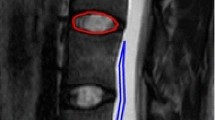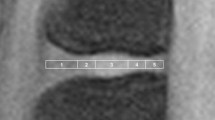Abstract
Objective
Our aim was to assess the microstructural changes of intervertebral disc degeneration induced by annulus needle puncture in rats by diffusion kurtosis imaging (DKI).
Methods
Eighteen rats (36 discs) were punctured percutaneously at the intervertebral disc between C6/7, C7/8 (C-coccygeal vertebrae) with a 21-gauge needle. The rats were divided into six groups according to the time after the puncture: 3 h, 48 h, 3 days, 7 days, 10 days and 14 days. There were six discs in three rats in the control group. The rats’ tail was imaged at 3T MRI with T2-weighted and diffusion-weighted and diffusion kurtosis imaging (DWI)/DKI sequences. The discs were categorized using a five-grade degeneration system based on the T2 images. The height of the discs and the parameters in DWI/DKI were measured and compared between the different time points. The histological images were also obtained from the discs.
Results
The histological study revealed that the discs in the rat of the punctured groups were degenerated. The T2 grades of different groups presented an increasing trend from 7 to 10 days after puncture (R2 = 0.9424, P < 0.001), while the DWI/DKI parameters changes were consistent with the histological changes at the different time points and showed significant differences between the different groups (P < 0.05).
Conclusions
DKI provides quantitative assessment of the microstructure changes of disc degeneration, and it is a non-invasive method. The DKI multi-parameter analysis is sensitive to discs changes caused by puncture.
Graphical abstract
These slides can be retrieved under Electronic Supplementary Material.





Similar content being viewed by others
References
Issy AC, Castania V, Castania M et al (2013) Experimental model of intervertebral disc degeneration by needle puncture in Wistar rats. Braz J Med Biol Res 46(3):235–244
Yurube T, Hirata H, Kakutani K et al (2014) Notochordal cell disappearance and modes of apoptotic cell death in a rat tail static compression-induced disc degeneration model. Arthritis Res Ther 16(1):R31
Silveira JW, Issy AC, Castania VA et al (2014) Protective effects of cannabidiol on lesion-induced intervertebral disc degeneration. PLoS ONE 9(12):e113161
Issy AC, Castania V, Silveira JW et al (2015) Does a small size needle puncture cause intervertebral disc changes. Acta Cir Bras 30(8):574–579
Inoue H, Montgomery SR, Aghdasi B et al (2015) The effect of bone morphogenetic protein-2 injection at different time points on intervertebral disk degeneration in a rat tail model. J Spinal Disord Tech 28(1):E35–E44
Li D, Yang H, Huang Y, Wu Y, Sun T, Li X (2014) Lumbar intervertebral disc puncture under C-arm fluoroscopy: a new rat model of lumbar intervertebral disc degeneration. Exp Anim 63(2):227–234
Han B, Zhu K, Li FC et al (2008) A simple disc degeneration model induced by percutaneous needle puncture in the rat tail. Spine (Phila Pa 1976) 33(18):1925–1934
Iima M, Kataoka M, Kanao S et al (2018) Intravoxel incoherent motion and quantitative non-Gaussian diffusion MR imaging: evaluation of the diagnostic and prognostic value of several markers of malignant and benign breast lesions. Radiology 287(2):432–441
Falk DA, Nilsson M, van Westen D, Falk DA (2018) Glioma grade discrimination with MR diffusion kurtosis imaging: a meta-analysis of diagnostic accuracy. Radiology 287(1):119–127
Wang WT, Yang L, Yang ZX et al (2018) Assessment of microvascular invasion of hepatocellular carcinoma with diffusion kurtosis imaging. Radiology 286(2):571–580
McClymont D, Teh I, Carruth E et al (2017) Evaluation of non-Gaussian diffusion in cardiac MRI. Magn Reson Med 78(3):1174–1186
Ruan W, Zhong J, Guan Y et al (2017) Detection of smoke-induced pulmonary lesions by hyperpolarized 129 Xe diffusion kurtosis imaging in rat models. Magn Reson Med 78(5):1891–1899
Shi RY, Yao QY, Zhou QY et al (2017) Preliminary study of diffusion kurtosis imaging in thyroid nodules and its histopathologic correlation. Eur Radiol 27(11):4710–4720
Zhuo J, Xu S, Proctor JL et al (2012) Diffusion kurtosis as an in vivo imaging marker for reactive astrogliosis in traumatic brain injury. Neuroimage 59(1):467–477
Li L, Zhu W, Chen W, Fang J, Li J (2017) The study of the intervertebral disc microstructure in matured rats with diffusion kurtosis imaging. Magn Reson Imaging 42:101–106
Pfirrmann CW, Metzdorf A, Zanetti M, Hodler J, Boos N (2001) Magnetic resonance classification of lumbar intervertebral disc degeneration. Spine (Phila Pa 1976) 26(17):1873–1878
Hsieh AH, Hwang D, Ryan DA, Freeman AK, Kim H (2009) Degenerative anular changes induced by puncture are associated with insufficiency of disc biomechanical function. Spine (Phila Pa 1976) 34(10):998–1005
Li J, Guan H, Liu H et al (2017) Epoxyeicosanoids prevent intervertebral disc degeneration in vitro and in vivo. Oncotarget 8(3):3781–3797
Keorochana G, Johnson JS, Taghavi CE et al (2010) The effect of needle size inducing degeneration in the rat caudal disc: evaluation using radiograph, magnetic resonance imaging, histology, and immunohistochemistry. Spine J 10(11):1014–1023
Masuda K, Aota Y, Muehleman C et al (2005) A novel rabbit model of mild, reproducible disc degeneration by an anulus needle puncture: correlation between the degree of disc injury and radiological and histological appearances of disc degeneration. Spine (Phila Pa 1976) 30(1):5–14
Zhang S, Zhu W, Zhang Y et al (2017) Diffusional kurtosis imaging in evaluating the secondary change of corticospinal tract after unilateral cerebral infarction. Am J Transl Res 9(3):1426–1434
Adams MA, Roughley PJ (2006) What is intervertebral disc degeneration, and what causes it. Spine (Phila Pa 1976) 31(18):2151–2161
Battié MC, Videman T (2006) Lumbar disc degeneration: epidemiology and genetics. J Bone Joint Surg Am 88(Suppl 2):3–9
Roberts S, Evans H, Trivedi J, Menage J (2006) Histology and pathology of the human intervertebral disc. J Bone Joint Surg Am 88(Suppl 2):10–14
Author information
Authors and Affiliations
Corresponding author
Ethics declarations
Conflict of interest
None of the authors has any potential conflict of interest.
Additional information
Publisher's Note
Springer Nature remains neutral with regard to jurisdictional claims in published maps and institutional affiliations.
Electronic supplementary material
Below is the link to the electronic supplementary material.
Rights and permissions
About this article
Cite this article
Li, L., Zhou, Z., Li, J. et al. Diffusion kurtosis imaging provides quantitative assessment of the microstructure changes of disc degeneration: an in vivo experimental study. Eur Spine J 28, 1005–1013 (2019). https://doi.org/10.1007/s00586-019-05924-3
Received:
Revised:
Accepted:
Published:
Issue Date:
DOI: https://doi.org/10.1007/s00586-019-05924-3




